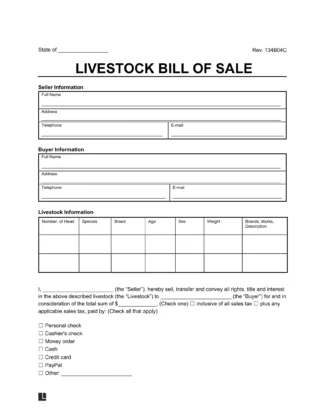
Use a livestock bill of sale form when selling farm or ranch animals.

Updated January 21, 2024
Written by Josh Sainsbury | Reviewed by Brooke Davis
A livestock bill of sale is a formal document that records the details of a transaction where livestock (such as cattle, sheep, horses, pigs, goats, etc.) is sold from one party to another.
This document serves multiple crucial functions in such transactions:
In addition, this document can be critical for tax and legal purposes, serving as a record of the transaction for reporting income or expenses and verifying the livestock’s origin and ownership in compliance with regulations or industry standards. In some cases, a livestock bill of sale might be required for transporting animals across state lines or for certain agricultural programs or subsidies.
A livestock bill of sale is a legal document used to record the sale of livestock from one party to another.
It typically includes information such as a description of the livestock being sold (including the type, breed, age, and gender of the animals), the addresses and names of the buyer and seller, the purchase price, and any agreed-upon terms and conditions of the sale.
A bill of sale for livestock is essential because it serves as proof of ownership and transfer of the livestock from the seller to the buyer. It can also be used as a legal record for tax purposes and in the event of any disputes or legal issues arising from the sale of livestock.
The exact contents of a livestock bill of sale may vary depending on the specific circumstances of the sale and the requirements of the state or country where it is used.
A livestock bill of sale is typically used whenever livestock is sold from one party to another. Examples of these situations include:
Buying or selling livestock privately: It can be used to document the details of the transaction and provide proof of ownership if you’re purchasing or selling livestock outside of a formal auction or other sales venue.
Trading livestock between farmers or ranchers: It can help ensure that both parties are clear on the transaction terms and that the transfer of ownership is legally valid if you’re a farmer or rancher who frequently trades livestock with other producers.
Selling livestock at a public auction: It can still help document the transaction’s details and provide a record of ownership transfer, while many sales conducted through public auctions have their own sales contracts.
Overall, a livestock bill of sale is an essential document for anyone buying or selling farm animals because it creates a legal record of the transaction and can help prevent disputes or misunderstandings in the future.
If you’re looking to sell livestock privately, there are several steps you can take to ensure a successful transaction. Here are some general steps to follow:
Do some research to determine the current market value of your livestock based on factors such as breed, age, gender, and health. This will help you set a fair asking price for the livestock animals.
Create an advertisement for your livestock and post it online or in local newspapers and other publications.
Be sure to include photos, a detailed description of the animals, and other relevant information, such as their health status, vaccination records, etc.
Once you start receiving inquiries from potential buyers, be prepared to answer questions about your livestock and arrange for buyers to see the animals in person.
Once a potential buyer has expressed interest in purchasing your livestock, negotiate the terms of the sale, including the purchase price, payment method, and any other details, such as delivery or pickup arrangements.
After you’ve agreed to the terms of the deal, create a bill of sale to document the transaction and provide proof of ownership transfer.
Be sure to include all the necessary details in the document, as outlined above.
Once both parties have signed the document, transfer ownership of the animals to the buyer by physically delivering them to the buyer or arranging for pickup.
It’s important to remember that selling livestock privately can come with risks, such as potential scams or disputes over the condition of the animals. Working with a legal expert is always wise to ensure paperwork is legally valid and protects your interests.
A livestock bill of sale should include key elements to ensure it’s a legally valid document and accurately reflects the transaction details.
Some of the elements that should be included are:
Names and addresses of the buyer and seller: The full legal names and addresses of both the buyer and seller should appear in the document.
Description of the livestock: The document should provide a detailed description of the livestock being sold, including the type of animal, breed, age, gender, and any distinguishing characteristics or markings.
Purchase price: You should clearly state the purchase price agreed upon by the buyer and seller.
Payment terms: If the purchase price is to be paid in installments or differently, the document should clearly outline those terms.
Delivery details: The document should include where and when the livestock will be delivered to the buyer.
Representations and Warranties: The seller may wish to include certain representations and warranties, such as guaranteeing that the livestock is healthy and disease-free.
Signatures: The buyer and seller should sign the bill of sale, and it may be a good idea to have the document witnessed or notarized as well.
It’s vital to note that the elements included in a livestock bill of sale may vary depending on the state where the document is being used.